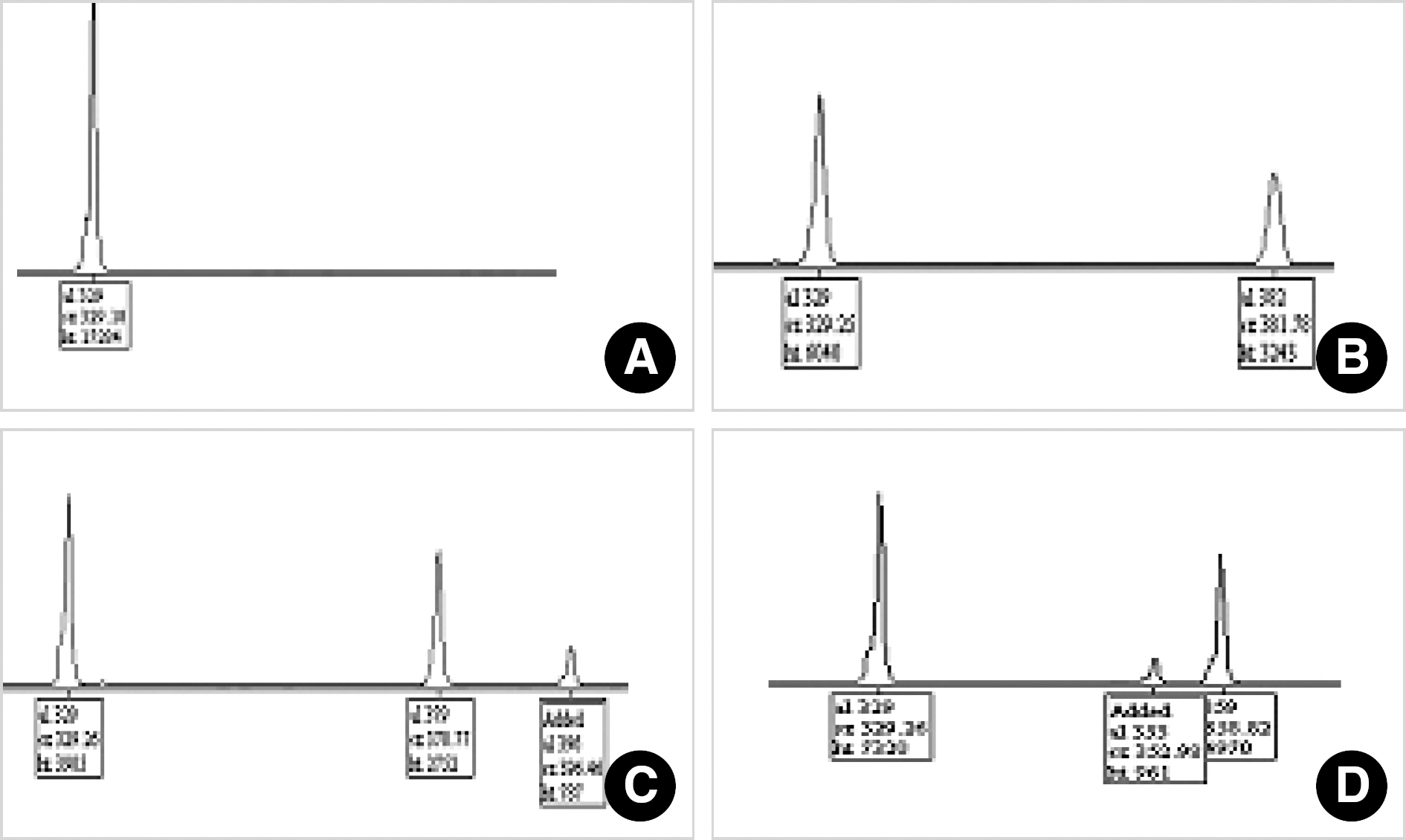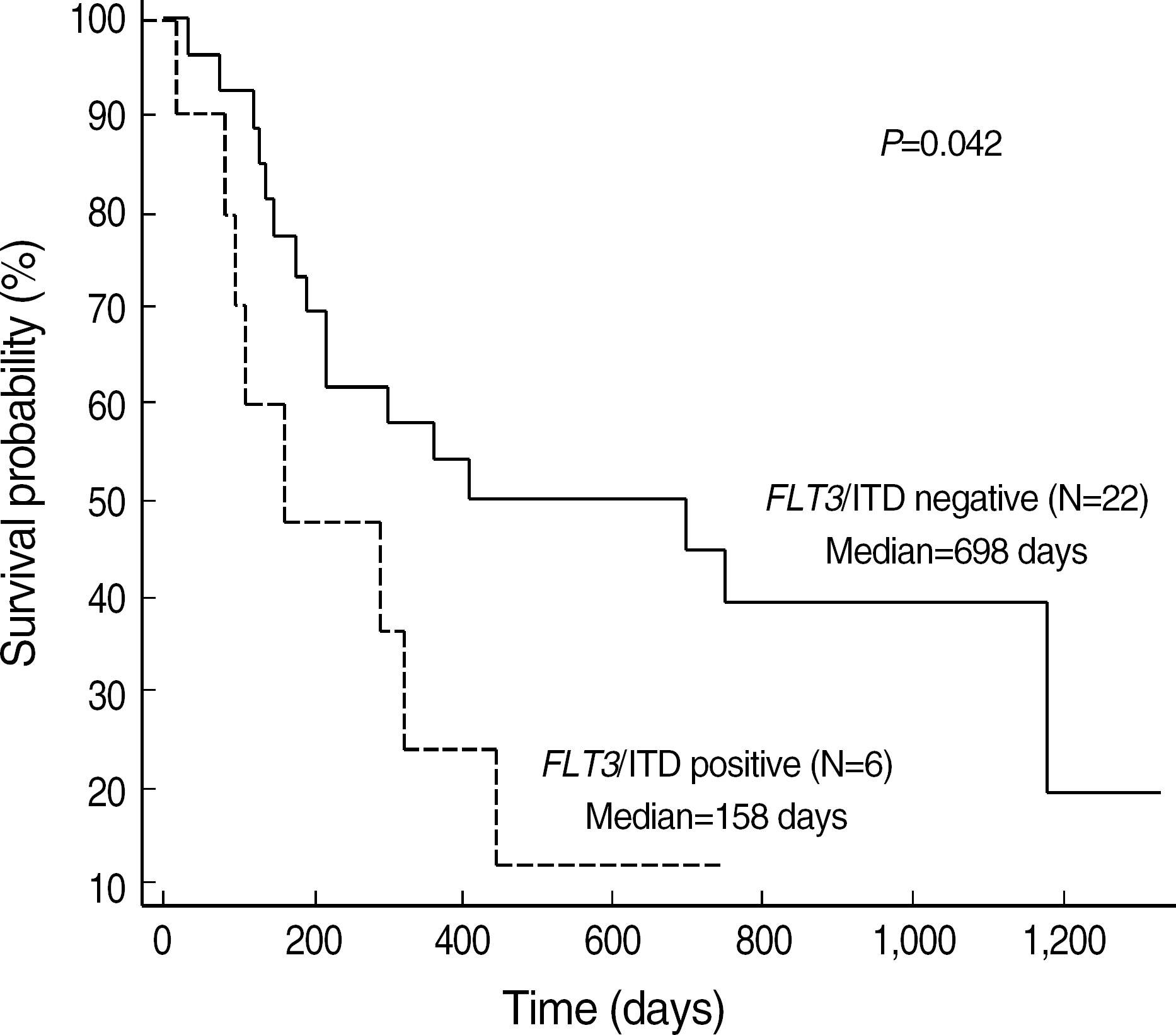Korean J Lab Med.
2007 Aug;27(4):237-243. 10.3343/kjlm.2007.27.4.237.
Prevalence of FLT3 Internal Tandem Duplication in Adult Acute Myelogenous Leukemia
- Affiliations
-
- 1Department of Laboratory Medicine, Busan Paik Hospital, College of Medicine, Korea. jeong418@medimail.co.kr
- 2Department of Internal Medine, Busan Paik Hospital, College of Medicine, Korea.
- 3Paik Institute for Clinical Research, Inje University, Busan, Korea.
- KMID: 1781490
- DOI: http://doi.org/10.3343/kjlm.2007.27.4.237
Abstract
- BACKGROUND: fms-like tyrosine kinase (FLT3), a member of the class III receptor tyrosine kinases, regulates the proliferation and differentiation of hematopoietic stem cells. An internal tandem duplication of the FLT3 gene (FLT3/ITD) has been reported in acute myelogenous leukemia (AML) and may be associated with a poor prognosis. In this study we determined the prevalence and prognostic significance of FLT3/ITD in adult AML patients. METHODS: This study included 52 adult de novo AML. Exon 14 and 15 of the FLT3 gene were amplified by PCR and the PCR products were analyzed by 3730XL DNA analyzer (Applied Biosystems, USA) and GeneMapper Software. RESULTS: FLT3/ITD was found in 15 (28.8%) of the 52 AML patients. The presence of FLT3/ITD was significantly associated with absolute leukocyte counts (P=0.002) and bone marrow blast counts (P=0.036). FLT3/ITD was also more frequent in patients with normal karyotype (7 of 18) than in those with cytogenetic aberrations (3 of 25). Patients with t (15;17) showed a higher prevalence of FLT3/ITD (2 of 7). FLT3/ITD was significantly associated with overall survival (P<0.042). CONCLUSIONS: Our data indicate that FLT3/ITD is a common alteration in adult AML patients. Although based on a study with a limited number of AML patients, FLT3/ITD is a prognostic marker in patients with AML.
Keyword
MeSH Terms
Figure
Cited by 1 articles
-
Prognostic Significance of
FLT3 Internal Tandem Duplication in Acute Myeloid Leukemia with Normal Karyotype
Ja Young Lee, Young Don Joo, Seung Hwan Oh, Jeong Hwan Shin, Hye Ran Kim, Sang Min Lee, Jeong Nyeo Lee
Korean J Hematol. 2009;44(2):74-81. doi: 10.5045/kjh.2009.44.2.74.
Reference
-
References
1. McKenna HJ, Stocking KL, Miller RE, Brasel K, De Smedt T, Maraskovsky E, et al. Mice lacking flt3 ligand have deficient hematopoiesis affecting hematopoietic progenitor cells, dendritic cells, and natural killer cells. Blood. 2000; 95:3489–97.
Article2. Lyman SD, Jacobsen SE. c-kit ligand and Flt3 ligand: stem/progenitor cell factors with overlapping yet distinct activities. Blood. 1998; 91:1101–34.
Article3. Hannum C, Culpepper J, Campbell D, McClanahan T, Zurawski S, Bazan JF, et al. Ligand for FLT3/FLK2 receptor tyrosine kinase regulates growth of haematopoietic stem cells and is encoded by variant RNAs. Nature. 1994; 368:643–8.
Article4. Weiss A, Schlessinger J. Switching signals on or off by receptor dimerization. Cell. 1998; 94:277–80.
Article5. Kiyoi H, Towatari M, Yokota S, Hamaguchi M, Ohno R, Saito H, et al. Internal tandem duplication of the FLT3 gene is a novel modality of elongation mutation which causes constitutive activation of the product. Leukemia. 1998; 12:1333–7.
Article6. Hayakawa F, Towatari M, Kiyoi H, Tanimoto M, Kitamura T, Saito H, et al. Tandem-duplicated Flt3 constitutively activates STAT5 and MAP kinase and introduces autonomous cell growth in IL-3-dependent cell lines. Oncogene. 2000; 19:624–31.
Article7. Yamamoto Y, Kiyoi H, Nakano Y, Suzuki R, Kodera Y, Miyawaki S, et al. Activating mutation of D835 within the activation loop of FLT3 in human hematologic malignancies. Blood. 2001; 97:2434–9.
Article8. Fenski R, Flesch K, Serve S, Mizuki M, Oelmann E, Kratz-Albers K, et al. Constitutive activation of FLT3 in acute myeloid leukaemia and its consequences for growth of 32D cells. Br J Haematol. 2000; 108:322–30.
Article9. Kiyoi H, Naoe T, Nakano Y, Yokota S, Minami S, Miyawaki S, et al. Prognostic implication of FLT3 and N-RAS gene mutations in acute myeloid leukemia. Blood. 1999; 93:3074–80.10. Abu-Duhier FM, Goodeve AC, Wilson GA, Gari MA, Peake IR, Rees DC, et al. FLT3 internal tandem duplication mutations in adult acute myeloid leukaemia define a high-risk group. Br J Haematol. 2000; 111:190–5.
Article11. Frohling S, Schlenk RF, Breitruck J, Benner A, Kreitmeier S, Tobis K, et al. Prognostic significance of activating FLT3 mutations in younger adults (16 to 60 years) with acute myeloid leukemia and normal cytogenetics: a study of the AML Study Group Ulm. Blood. 2002; 100:4372–80.12. Thiede C, Steudel C, Mohr B, Schaich M, Schakel U, Platzbecker U, et al. Analysis of FLT3-activating mutations in 979 patients with acute myelogenous leukemia: association with FAB subtypes and identification of subgroups with poor prognosis. Blood. 2002; 99:4326–35.
Article13. Kottaridis PD, Gale RE, Frew ME, Harrison G, Langabeer SE, Belton AA, et al. The presence of a FLT3 internal tandem duplication in patients with acute myeloid leukemia (AML) adds important prognostic information to cytogenetic risk group and response to the first cycle of chemotherapy: analysis of 854 patients from the United Kingdom Medical Research Council AML 10 and 12 trials. Blood. 2001; 98:1752–9.
Article14. Rombouts WJ, Blokland I, Lowenberg B, Ploemacher RE. Biological characteristics and prognosis of adult acute myeloid leukemia with internal tandem duplications in the Flt3 gene. Leukemia. 2000; 14:675–83.
Article15. Meshinchi S, Woods WG, Stirewalt DL, Sweetser DA, Buckley JD, Tjoa TK, et al. Prevalence and prognostic significance of Flt3 internal tandem duplication in pediatric acute myeloid leukemia. Blood. 2001; 97:89–94.
Article16. Zwaan CM, Meshinchi S, Radich JP, Veerman AJ, Huismans DR, Munske L, et al. FLT3 internal tandem duplication in 234 children with acute myeloid leukemia: prognostic significance and relation to cellular drug resistance. Blood. 2003; 102:2387–94.
Article17. Yoo SJ, Shim EH, Park CJ, Chi HS. The frequency and clinical significance of FLT3 gene mutation in acute promyelocytic leukemia. Korean J Lab Med. 2003; 23(S1):174.18. Chang SH, Lee NY, Kim DH, Sohn SK, Suh JS. FLT3 Gene mutations as a prognostic factor for acute myeloid leukemia. Korean J Lab Med. 2006; 26:233–40.19. Sohn YH, Chi HS, Joo MY, Huh HJ, Jang SS, Park CJ. Investigation of Correlation of the recurrence of acute myolgenous leukemia and FLT3 mutation. Korean J Lab Med. 2004; 24(S2):402.20. Agnes F, Shamoon B, Dina C, Rosnet O, Birnbaum D, Galibert F. Genomic structure of the downstream part of the human FLT3 gene: exon/intron structure conservation among genes encoding receptor tyrosine kinases (RTK) of subclass III. Gene. 1994; 145:283–8.
Article21. Gilliland DG, Griffin JD. The roles of FLT3 in hematopoiesis and leukemia. Blood. 2002; 100:1532–42.
Article22. Wang L, Lin D, Zhang X, Chen S, Wang M, Wang J. Analysis of FLT3 internal tandem duplication and D835 mutations in Chinese acute leukemia patients. Leuk Res. 2005; 29:1393–8.
Article23. Schnittger S, Schoch C, Dugas M, Kern W, Staib P, Wuchter C, et al. Analysis of FLT3 length mutations in 1003 patients with acute myeloid leukemia: correlation to cytogenetics, FAB subtype, and prognosis in the AMLCG study and usefulness as a marker for the detection of minimal residual disease. Blood. 2002; 100:59–66.
Article24. Boissel N, Renneville A, Biggio V, Philippe N, Thomas X, Cayuela JM, et al. Prevalence, clinical profile, and prognosis of NPM mutations in AML with normal karyotype. Blood. 2005; 106:3618–20.
Article25. Boissel N, Cayuela JM, Preudhomme C, Thomas X, Grardel N, Fund X, et al. Prognostic significance of FLT3 internal tandem repeat in patients with de novo acute myeloid leukemia treated with reinforced courses of chemotherapy. Leukemia. 2002; 16:1699–704.
Article26. Rombouts WJ, Martens AC, Ploemacher RE. Identification of variables determining the engraftment potential of human acute myeloid leukemia in the immunodeficient NOD/SCID human chimera model. Leukemia. 2000; 14:889–97.
Article27. Kainz B, Heintel D, Marculescu R, Schwarzinger I, Sperr W, Le T, et al. Variable prognostic value of FLT3 internal tandem duplications in patients with de novo AML and a normal karyotype, t(15;17), t(8;21) or inv(16). Hematol J. 2002; 3:283–9.
Article28. Cloos J, Goemans BF, Hess CJ, van Oostveen JW, Waisfisz Q, Corthals S, et al. Stability and prognostic influence of FLT3 mutations in paired initial and relapsed AML samples. Leukemia. 2006; 20:1217–20.
Article
- Full Text Links
- Actions
-
Cited
- CITED
-
- Close
- Share
- Similar articles
-
- Prognostic Significance of FLT3 Internal Tandem Duplication in Acute Myeloid Leukemia with Normal Karyotype
- Status of FLT3-ITD Analysis in Korea (2021)
- FLT3 Internal Tandem Duplication in Patients With Acute Myeloid Leukemia Is Readily Detectable in a Single Next-Generation Sequencing Assay Using the Pindel Algorithm
- FLT3 Internal Tandem Duplication in Acute Myeloid Leukemia with Normal Karyotype
- Prognostic significance of nucleophosmin mutations and FLT3 internal tandem duplication in adult patients with cytogenetically normal acute myeloid leukemia



